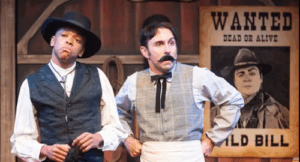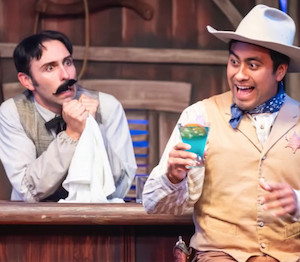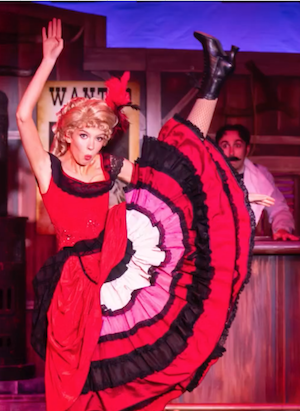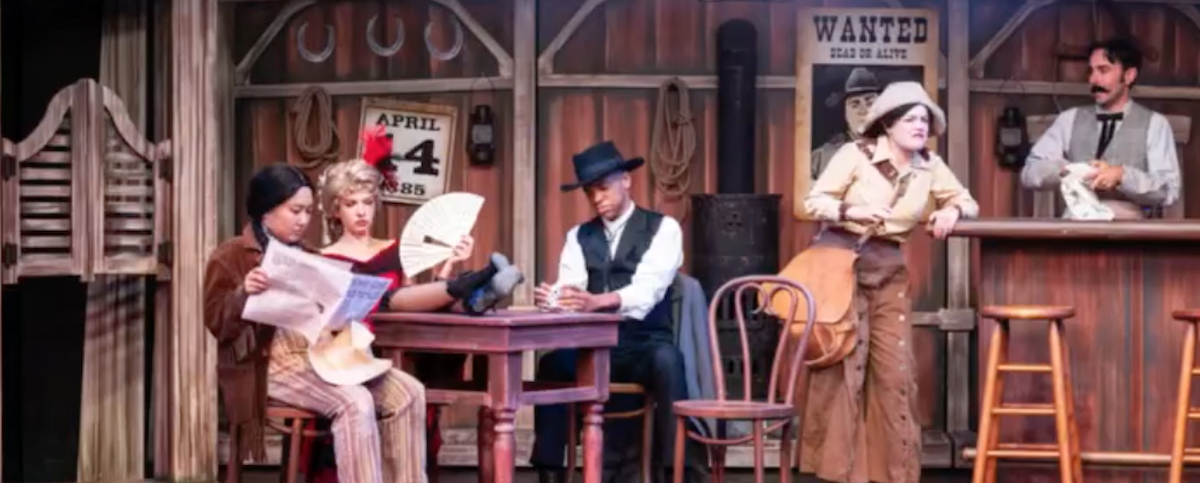It’s the olden times of the wild, wild, west in the town of Deadwater, Arizona, and there are good guys and bad guys and cantankerous characters galore. Oh, and comedy, of course, because despite the “wanted” posters hanging on the wall in the town saloon (good job, scenic artist Jason Bolen) and the crimson petticoats worn by the town floozy (good job, costume designer Barbara Abbott), we are really paying a visit to The Great American Melodrama in modern-day Oceano, California.
 It’s How the West Was Really Won, a two-hour, multiple set, energetic and often surprising romp featuring hilarious American frontier stereotypes of the late 1800s: a gunslinger (cue the booing and hissing), two saloon keepers, a dance-hall girl, an evil railroad baron(ess), a whiskey-drinking miner, even an undertaker. And of course there is a hero (cue the cheering)—the brave sheriff who (spoiler alert) manages to stay alive despite his predecessors being routinely gunned down within days of assuming the post.
It’s How the West Was Really Won, a two-hour, multiple set, energetic and often surprising romp featuring hilarious American frontier stereotypes of the late 1800s: a gunslinger (cue the booing and hissing), two saloon keepers, a dance-hall girl, an evil railroad baron(ess), a whiskey-drinking miner, even an undertaker. And of course there is a hero (cue the cheering)—the brave sheriff who (spoiler alert) manages to stay alive despite his predecessors being routinely gunned down within days of assuming the post.
 Throughout it all—shootouts, fistfights, card-playing, even a bit of virtuous wooing—director Karin Hendricks-Bolen and her fine cast never forget that the Melodrama audience is watching. Playing directly to the house certainly isn’t anything new in this theatre on Front Street in Oceano, but this show seems determined to break the fourth wall at every turn.
Throughout it all—shootouts, fistfights, card-playing, even a bit of virtuous wooing—director Karin Hendricks-Bolen and her fine cast never forget that the Melodrama audience is watching. Playing directly to the house certainly isn’t anything new in this theatre on Front Street in Oceano, but this show seems determined to break the fourth wall at every turn.
The actors deftly bring us into the jokes—at one point even hauling an observer onto the stage to join a card game—and constantly comment on everything from the plot (“lazy writing”) to character development (a bad guy must “continue his redemption arc”). Could the adaptations by local playwright Ben Abbott to the original script by Arnold Carlos have something to do with this?
 The funniest moments in the show come during a couple of ridiculously comical rescues: a fortuitous fire saves bad guy Wild Bill from hanging, and in the end a little dog saves the day (no spoiler alerts here: you won’t see these scenes coming!). Fight scenes are both impressive (good job, fight choreographer Pater Hadres) and impressively slapstick (an extended bout between the sheriff and a hired gun will leave you in stitches, thanks to a little help from the prop department).
The funniest moments in the show come during a couple of ridiculously comical rescues: a fortuitous fire saves bad guy Wild Bill from hanging, and in the end a little dog saves the day (no spoiler alerts here: you won’t see these scenes coming!). Fight scenes are both impressive (good job, fight choreographer Pater Hadres) and impressively slapstick (an extended bout between the sheriff and a hired gun will leave you in stitches, thanks to a little help from the prop department).
Only two of the seven-member cast get to play single roles throughout the evening: a steady Johnny Valerio plays the steady, good-hearted (despite his name) Sheriff Snake, and the very versatile Joshua Kenebrew plays the town undertaker, who is constantly measuring bodies (alive and newly dead alike).
The other five take on 14 roles with the gusto of versatile and veteran melodrama actors who take many fast and furious costume changes in stride.
Noah Esquival displays quite a range, appearing in black as Wild Bill (the villain in the first act), in full beard as Jasper the miner, and in sailor hat as a not-so-small boy named Teddy. Tony Costa shows off his expressive face and voice with Bible in hand as a bailiff, in a bowler hat as Irish hired gun McMurphy, and in apron behind the saloon bar as Ned—sorry, Fred.
 Annaliese Chambers, limber of limb and voice, plays saloon floozy Mustang Sally as well as the tongue-tied saloon hanger-on Buck. Madeline Gambon gets to play a card player and a juror before finding her big voice as Fae/Mae West (just in time for her big musical number “I Won’t Let It Happen Twice”).
Annaliese Chambers, limber of limb and voice, plays saloon floozy Mustang Sally as well as the tongue-tied saloon hanger-on Buck. Madeline Gambon gets to play a card player and a juror before finding her big voice as Fae/Mae West (just in time for her big musical number “I Won’t Let It Happen Twice”).
Carley Herlihy starts out as a card player, but quickly makes her mark as both good guy and bad: pounding a gavel as Judge Judy (Trudy?) and then as Cooper, the villain of the second act.
How the West Was Really Won will win you over with its joyful performances and enthusiastic embrace of the audience.
While we always expect melodramas to give us a wink and a nod, How the West Was Really Won is meta almost in the extreme. It’s as self-referential a show as you’re likely to see at The Great American Melodrama. In its way it’s as welcoming a device as the unfailing acknowledgement of audience birthdays and anniversaries during every Melodrama show’s intermission. After all, you can’t have a real melodrama without the audience booing and hissing and clapping and participating in the fun.
Belly up to the bar in Deadwood’s saloon as a fitting build-up to the company’s next offering: its 50th Anniversary Spectacular, billed as a sampler of half a century of Melodrama shows with favorite bits from past years as well as new song, dance, and comedy material. Like this show, it’s sure to be an audience favorite.
